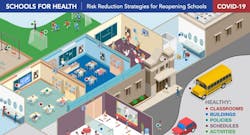BACK TO SCHOOL? 20 Questions To Ask Before The Bell Rings
Getting kids back to school must be a national priority.
The risks to students from school closures, including “virtual dropouts”, lack of food security, safety, and adverse impacts on social, physical and mental health, must be weighed against risks from being back in school. The scientific evidence to date about COVID-19 tells us that kids are:
- less likely to get infected than adults
- less likely to suffer severe effects if infected
- less likely to transmit to others (particularly true of those aged 0-9 years old)
There is no such thing as “zero risk” in anything we do, and certainly not during a pandemic. There will be some risk to students, teachers, staff, and families. As such, it is important to reduce these risks to the extent possible.
Returning to school should not be “school as usual.” While we offer some insight into the responses you might receive, and expect, each school’s response will be different because there is no “one size fits all” plan for COVID-19.
For more details, we encourage you to read the full report.
We prepared the following set of questions as a guide for parents, teachers and school staff who may not be sure what to ask or look for at their school.
1. Are the number of cases in the area low enough for schools to reopen?
2. When and how will masks be required and how will the school support mask use?
3. Will hand washing stations or hand sanitizer be available throughout the school and when will children be required to wash their hands?
4. When and how will physical distancing be maintained throughout the school day?
5. Will outdoor air supply rates (ventilation) be increased in school buildings, including classrooms, and how will the school verify that ventilation is adequate?
6. Does the ventilation system use a filter with a rating of MERV 13 or higher for the air going into classrooms and has it been inspected or replaced recently?
7. Will portable air cleaners with HEPA filters be used in classrooms and other relevant spaces in the school?
8. Will any physical barriers (e.g., plexiglass) be installed in the school?
9. Will de-densification strategies, like staggered arrival and dismissal times, be implemented?
10. Will the school consider using alternative classroom and lunchroom spaces?
11. How will the school limit the amount of shared surfaces and what is the plan for regularly disinfecting surfaces throughout the entire school?
12. How will transportation to and from school change when school reopens?
13. Who is the “point person” or person in charge of the COVID-19 response team/plan and how will they communicate changes in school policy to parents/students?
14. What guidance for contact tracing, testing, and quarantine/isolation is in place in the event that my child’s teacher or another student in the class contracts COVID-19?
15. How will parents, students, and staff be educated about symptoms and will temperature or other health checks be done on students, staff and teachers every day?
16. If a teacher or student has to stay home, what strategies are in place to support remote work or learning and make sure students don’t fall behind in their schoolwork?
17. What other policy changes are being considered to reduce COVID-19 transmission risk?
18. What precautions will there be during physical education, indoor choir, band, or theater to make these activities more safe?
19. Will recess be modified when schools reopen?
20. Will students be allowed to participate in sports?
CONTRIBUTORS
This is a joint project between scientists at Portland State University and the Healthy Buildings program at Harvard T.H. Chan School of Public Health.
Portland State University
Richard Corsi, Elliott Gall, Andrea Gall
Harvard T.H. Chan School of Public Health
Joseph Allen, Kimberly A. Clevenger, Jenna Lang, Emily Jones (on behalf of the Harvard Healthy Buildings program team)
DISCLAIMER
This document is provided for informational and educational purposes only. It is intended to offer guidance regarding questions about best practices regarding the general operations of buildings in an effort to reduce the risk of disease transmission, specifically novel coronavirus SARS-CoV-2 and the disease it causes, COVID-19. Adherence to any information included in this document will not ensure successful treatment in every situation, and the user should acknowledge that there is no “zero risk” scenario, that each building and situation are unique and some of the guidance contained in the document will not apply to all buildings, or countries outside the United States.
Furthermore, the document should not be deemed inclusive of all proper methods nor exclusive of other methods reasonably directed to obtaining the same results. The document is in no way intended to override or supersede guidance from government and health organizations, including, without limitation, the Centers for Disease Control and Prevention, the World Health Organization, the United States Government, and or any States. The information contained herein reflects the available information at the time the document was created. The user recognizes that details and information are changing daily, and new information and/or the results of future studies may require revisions to the document (and the general guidance contained therein) to reflect new data. We do not warrant the accuracy or completeness of the guidance in this document and assume no responsibility for any injury or damage to persons or property arising out of or related to any use of the report or for any errors or omissions.
